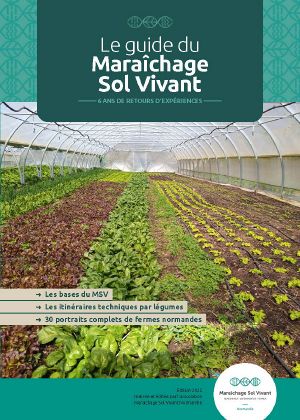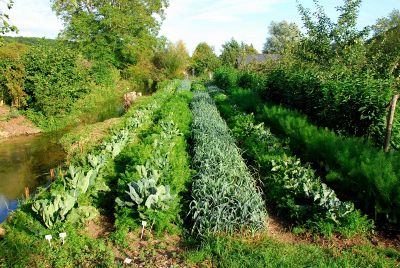 Agroforestry and combined orchards
Agroforestry and combined orchards
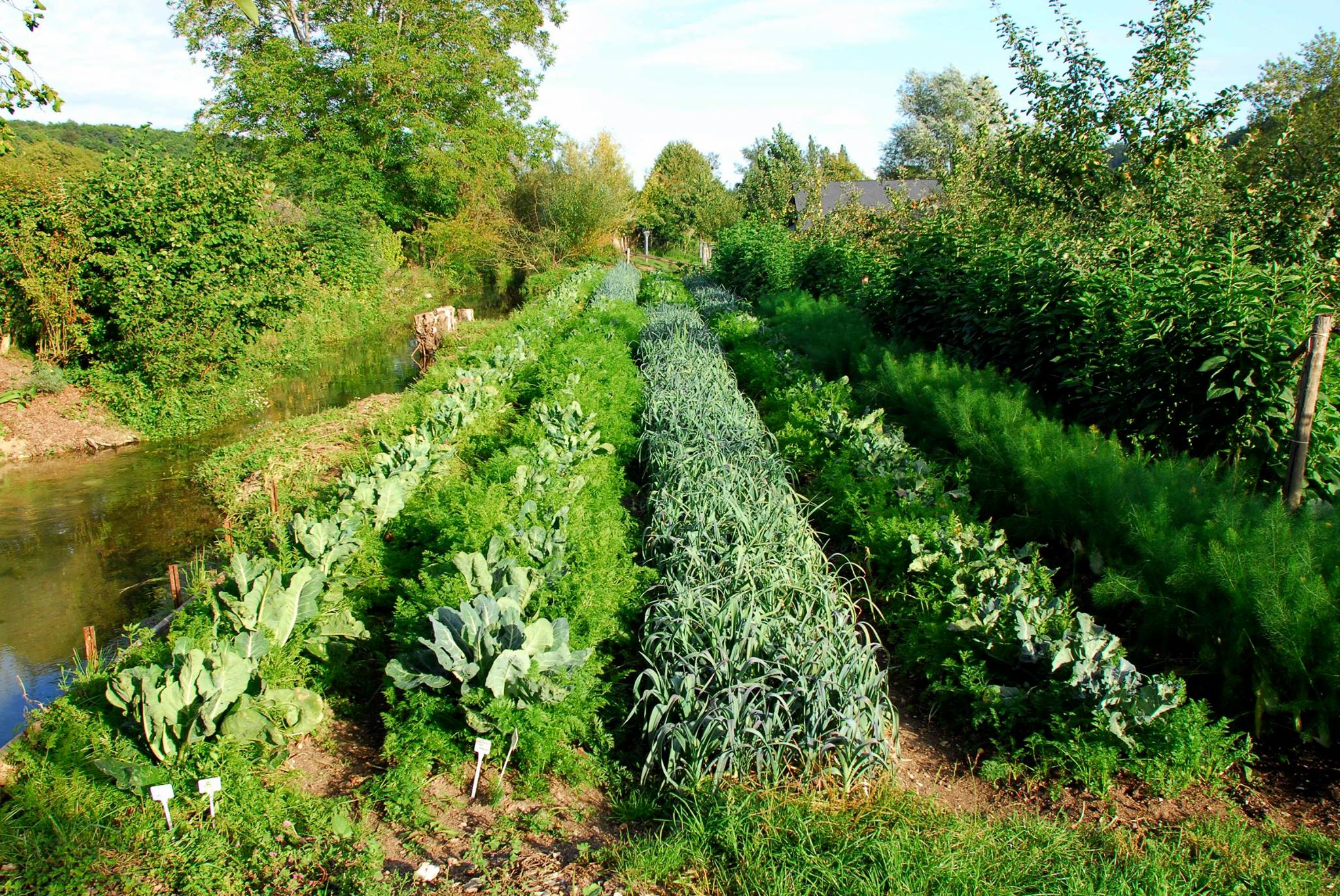
Themes
Market gard ening consists of combining vegetable and fruit crops on the same plot, thus forming several layers of vegetation. Combining complementary crops optimises the use of environmental resources (sunlight, water resources, nutrients, etc.). To develop a market garden, growers are often inspired by the principles of permaculture and living soil market gardening practices.
This type of agroforestry system tends to be developed on small areas (less than 5 ha), but has great potential for vegetable and fruit growing on a larger scale.
Benefits
Agro-ecological benefits
Implementing a market-garden orchard project provides multiple benefits in terms of soil fertility, water management, biodiversity and adaptation to climatic hazards :
- Deep rooting : this reduces the risk oferosion, particularly during periods of heavy rainfall. It also enables the return of mineral elements that cannot be reached by crops : the deep roots of the trees reach the soil and distribute them to the topsoil in the form of organic matter.
- Increased stability of aggregates : this allows better circulation of water and air in the soil, and therefore more microbial activity.
- Creation of clay and release of mineral elements from the soil : the acids and bases secreted by the roots attack the minerals in the rocks.
- Additional carbon storage in the aerial parts of the tree and in the organic matter incorporated into the soil by the roots.
- Improved soil water recharge in autumn.
- Reduced nitrate pollution of water : the tree can take nitrogen from the soil that is not captured by crops.
- Biodiversity, increase and diversification of auxiliaries : these mobile species can find refuge and food there. They provide natural regulation of pests(biological control) and pollination.
- Protection against climatic hazards, creation of a favourable micro-climate and reduction of stress : trees and hedges reduce wind speed and variations in air and soil temperature. They increase air humidity and limit evaporation of water from the soil.
- Aesthetic benefits for the landscape.
Economic and commercial benefits : diversification of production
Trees and hedges offer a wide range of edible products : orchard fruit, berries, roots, flowers, bark, sap, leaves and buds.
The wood produced can also be recycled, in the form of timber, energy wood, fodder, litter, or even as Ramial Fragmented Wood.
Tree-crop relationship : competition or synergy ?
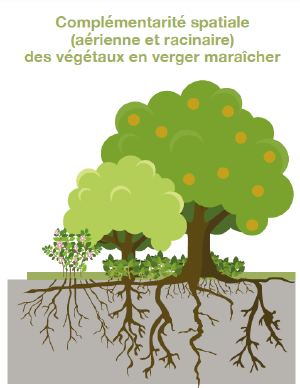
Interactions between trees and crops are both above and below ground. They give rise to competition and facilitation in the use of environmental resources (light, water, mineral elements).
The effects, both positive and negative, of these tree-crop interactions are often greatest in the immediate zone of influence of the trees. The entire surface of a plot is not impacted in the same way.
Light
Shade from trees reduces crop heating during hot spells.
Shade can also limit their growth. The risk is greater north of the Loire, where sunshine is limited. Isolated trees or trees on very weak rootstock (max. 4m high) should therefore be favoured in order to limit tree growth. Trees should be planted on the north side of the plot.
Water
Water competition is generally not a concern.
The tree's root system is an advantage (soil structuring, better water infiltration, etc.). Above all, the tree pumps deep water and does not compete with surface vegetables. Most of the water near the tree comes from groundwater, whereas at a distance of more than 2.5m from the tree, most of it comes from rainfall. The tree can also act as a hydraulic lift : water from the deep layers of the soil can rise through its roots and become available for crops.
Irrigation in market gardening is more sustained than in arable farming, which stimulates the root growth of trees in the vegetable horizon. This can accentuate competition. Competition can be limited by subsoiling the soil 1.5 m from the trees and 30 cm from the vegetables.
Soil
The effects on the chemical properties of the soil are mainly positive, but limited. A significant increase in organic carbon and the concentration of certain soil nutrients(N, P, K, Mg and Na) can be observed around tall, old hedges.
Some negative effects may occur, such as nitrogen mineralisation and the additional uptake of cations by trees, which may lead to an increase in soil acidity.
Subsoiling at a distance of 1.5 m from the row of trees at least every 3 years to a depth of around 30 cm can bring the tree roots deeper down and thus limit direct competition with vegetable crops.
And the grass ?
The uncultivated strip under the trees can act as a reservoir for weeds, which then spread to the cultivated plots. It is therefore necessary to mow the row regularly : at least twice a year, or even more if perennials are growing (bindweed, nettle, thistle, etc.).
Design of a market garden
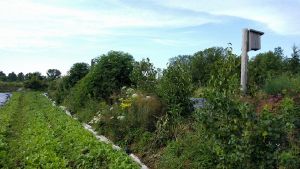
Setting up a market garden is no easy task. Training in arboriculture and organic farming is strongly encouraged before the project begins. Trees can be integrated :
- Either in the form of agroforestry hedges.
- Or as part of an intra-plot agroforestry system in the form of a market garden orchard.
Firstly, the priority is to make the most of the available resources by managing what already exists and protecting what grows naturally. Secondly, the planting of new trees can be envisaged.
Designing an orchard in space
Various criteria need to be taken into account when designing a market garden :
- Ensuring permanent access to the trees, depending on the type of mechanisation and the width required for tools to pass through.
- Define the inter-row and in-row spacing. Double rows allow fruit trees to be grouped together and make them easier to manage.
Density has a direct impact on crop yield. The recommended spacing between two trees is between 5 and 10 metres, but this depends on the type of tree and its future size. A minimum spacing of 10 metres between rows is recommended. In the south of France, where there is more sunshine, this distance can be reduced to 8 metres.
| Height of
fruit trees (metres) |
Minimum width
of spaces between market garden beds (metres) |
|---|---|
| 3 m | 11 m |
| 6 m | 16 m |
Feedback from experience shows that there is often a lack of space and encourages project developers to plan more widely.
For agroforestry, the density should be between 30 and 150 stems/ha.
- If density < 30-150 stems/ha : isolated trees.
- If density > 30-150 stems/ha : trees considered as afforestation, hedge or arboriculture.
- Opt for a row or staggered layout.
- Define the varietal distribution of trees : it makes sense to group varieties according to their earliness.
- Combine fruit and vegetable species according to theirshade tolerance and rooting capacity.
Orchard design in practice
- Avoid grass cover at the foot of the trees : covering, mulching.
- Plan harvesting methods.
- The management of tree pruning must be thought through before the project begins. This task can be outsourced to a professional or you can do it yourself, subject to a period of training. Pruning is a skill that needs to be mastered, as its effects can have a major impact.
In general, it is advisable toavoid trees in the shape of a ball (where the main stem has been cut off), as this shape is not conducive to tree development. Once the tree has been planted, its growth needs to be supervised by training pruning : the main task is to help the tree form its structure and adapt it to its environment and to what is expected of it (tractor traffic, fruit on high ground or not, etc.). Finally, maintenance pruning should be carried out over time, to ensure that the tree retains its desired shape (cutting back secondary branches, etc.) and to deal with any accidents (breakage, etc.).
Designing an orchard as part of a timetable
- Be aware of the organisational constraints of a market garden.
- Analyse peak work periods to avoid the trees becoming an extra burden or the vegetables underneath getting in the way of the harvest. If necessary, plan for seasonal labour.
Choosing varieties
Varieties are chosen according to several main criteria :
- Taste quality.
- Fertility.
- Hardiness of varieties (adapted to low input levels).
Varieties must not alternate production (one year out of two) and must not drop fruit prematurely.
Other criteria may also be taken into account, such as :
- Shelf life.
- Suitability for processing.
The varieties recommended by the members of the SMART project are as follows[1] :
| North North West France | South of France | |
|---|---|---|
| Apple | Boskoop
Canadian Grey Reinette Melrose Reinette Clochard Reinette d'Armorique Suntan type Cox's (Normandy) Benedictine (Normandy) Patte de Loup Cider apple varieties |
Garance
Pirouette Akane Pilot Écolette Chantecler Opal Dalinette Goldrush |
| Pear | Conference
President Heron General Leclerc Varieties of perry pears |
Clément pear
Heron President Harrow sweet Comice d'hiver Bergamot espéren |
| Plum | Reine Claude true
Reine Claude d'Oullins Quetsches Mirabelle plum Victoria |
Reine claude bavay
Quetsche d'Alsace |
| Cherry | Van
Stark Hardy Giant Hedelfingen Belgian Regina |
Burlat
Primulat Earlise® Fermina Fernier Régina |
| Apricot | /!risky in the North...
Polish Nancy Peach |
Bergeron
Kioto Wondercot Malice Polish Tomcot® Flavorcot® Harogem Solédane Fantasme Vertigo Hargrand |
| Fishing | Bénédicte®
Mireille Reine des Vergers Charles Roux Pêche de vigne |
Belle de Montélimar
BigBang® Coraline Chanas entrance Incomparable Guilloux Mrs Girerd Mireille Onyx® Tournier Ivory Redwing Bénédicte |
Choosing your rootstock
This stage is very important because the rootstock will remain in the orchard for a long time. The choice of rootstock depends on its vigour. Different types of rootstock can be distinguished according to their height, which reflects their vigour :
| Advantages | Disadvantages | |
|---|---|---|
| Rootstocks
" |
Limited height for easy picking |
|
| Rootstocks
" |
|
|
| Rootstocks
" |
|
|
Medium vigour rootstocks are preferable.
Planting trees
Planting periods
- Trees bought in pots (or containers) can be planted all year round, but the period from the beginning of September to the end of April is best for good recovery.
- Trees bought bare-root should be planted during the dormant season, i.e. between November and March, avoiding periods of heavy frost.
- Conifers, on the other hand, benefit from being planted early in autumn or in spring, when the soil begins to warm up.
Summer is an unfavourable time to plant trees, as drought represents a major risk for plants that have not yet established their root systems.
Preparing the soil and planting the tree
Ideally, the soil should be prepared (but not worked) 6 months before planting, by mulching the site with hay, straw, leaves, cardboard or wood shavings. A tarpaulin can also be used on grassland. The mulch should be at least 1 m wide to avoid root competition for the first 2 to 3 years of the tree's life.
If this preparation has not been done beforehand and the soil structure is poor(soil quality score of 3 or more), tillage will be necessary.
Preparing the soil
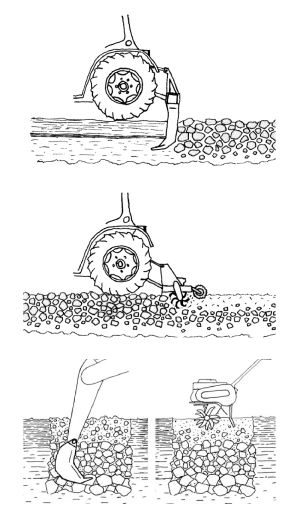
For hedges, the soil must be prepared to a width of 2 metres :
- Worked to a depth of : 50 cm to 80 cm using a subsoiler, decompactor or chisel.
- Refined to the equivalent of a seedbed using a rotary harrow (or rotavator).
For isolated trees, make "posts" :
- Loosen 1m30 : mechanical shovel or backhoe.
- Refine the surface : rototiller.
This method can also be used for hedges.
Planting hole
- Dig a deep, wide hole at least 2 times the size of the root ball.
- Loosen the bottom with a spade. If the soil is very heavy and clayey, provide a really substantial drainage layer (pebbles, gravel, etc.) because the planting hole is likely to fill up with water (another solution : plant slightly on a mound).
Choice of plant and size
- Choose young plants (less than 2 years old) rather than older plants, which will take longer to recover.
- For bare-root trees, prune the training crown if necessary.
- Prune the tips of the largest roots.
- Prune the roots by soaking them in a muddy mixture. Install a stake if necessary.
- For trees in rootballs or containers, decompact the rootball and free the roots before planting to avoid bunting.
Planting
- Place the tree in the hole (do not bury the grafting point), spreading out the roots and filling in the hole with the soil excavated from the surface. Mix with potting soil, compost and/or organic fertiliser if necessary, keeping the tree upright. Finish backfilling with the lower, less rich excavated soil and tamp lightly, creating a watering trough.
- Secure the stake to the trunk using a tie that does not damage the bark.
Watering
- Water generously when planting, even if it rains : around 20 litres per tree.
Grass management
- Mulch the entire surface of the planting hole if necessary, preferably with RCW or any other available mulch.
Financing the project and economic profitability
Financing a market garden project
In market gardening, the average costs of agroforestry trees are as follows [2] :
| Average cost of an agroforestry tree | Average cost of a grafted fruit tree | Average cost of a conventional forest plant |
|---|---|---|
| Between €16 and €18 excluding VAT | 14 BEFORE TAX | 2 BEFORE TAX |
These costs include the cost of seedlings, planting, protection, mulching, maintenance, technical support, etc. They therefore vary considerably depending on the species chosen and the installation and maintenance options chosen.
There are several possible sources of funding :
Public funding
- Subsidy arrangements depend on each region. However, in all regions, fruit trees must account for less than 50% of the trees planted on the plot (with the maximum number of trees varying from one region to another from 99 to 250 trees/ha). For further details, you can consult the regional chambers of agriculture and the leaflet on trees in the CAP.
- The Recovery Plan and other exceptional measures may be implemented from time to time.
Subsidies are subject to performance obligations.
Private funding
- Through associations such as the French Agroforestry Association or Des Enfants et des Arbres which rely on sponsorship from private organisations.
- Foundations such as Yves Rocher, Pur Projet or even GOOD PLANET.[3]
As a general rule, you should allow a year and a half between the first expenditure and repayment, regardless of the type of finance.
Economic profitability
The majority of market garden installations date from after 2010. While it has been possible to observe an increase in biodiversity in agroforestry, the concrete benefits ofagroforestry on agricultural production and producers' incomes are still uncertain. Setting up a market-garden orchard is therefore aimed at growers who have sufficient savings. An agroforestry project involves both technical and financial investment.
Feedback from agroforestry projects highlights the importance of the marketing channel in the success or failure of the project.[4] Marketing through short distribution channels makes it possible to increase the number of species grown and to raise consumer awareness of the agroforestry practices implemented. In the case of wholesale marketing, it is advisable to reduce the number of species and varieties grown.
Sources
- French Agroforestry Association. 2022. Le verger-maraîcher. [27/09/2022] https://www.agroforesterie.fr/verger-maraicher/
- Association Maraîchage Sol Vivant Normandie. 2022. Le Guide du Maraîchage Sol Vivant
- Le Jardin d'Essai. 2017. Agroforestry : investing in a market garden. https://www.jardin-essai.com/index.php/2017/11/17/agroforesterie-investir-dans-un-verger-maraicher/
- ↑ 1.0 1.1 1.2 1.3 Warlop F., Corroyer N., Denis A., Conseil M., Fourrié L., Duha G., Buchmann C., Lafon A., Servan G., 2017. Combining vegetables and fruit trees in agroforestry : Principles, technical elements and points to watch to design and manage your plot. SMART project. 40 p. June 2017.https://www.grab.fr/wp-content/uploads/2017/09/guide_verger-maraicher_smart_GRAB_web.pdf
- ↑ Ariège Chamber of Agriculture. 2022. AGROFORESTRY : WHAT AID FOR WHAT PROJECTS ?. https://ariege.chambre-agriculture.fr/actualites/toutes-nos-actualites/detail-de-lactualite/actualites/agroforesterie-quelles-aides-pour-quels-projets/
- ↑ AlterAgri. 2015. Agroforestry in France : overview. https://www.grab.fr/wp-content/uploads/2016/09/AA131-dossier-agroforesterie.pdf
- ↑ Donatien Jeanlin. Analyse des conditions de réussite de l'installation en vergers maraîchers. https://rmt-agroforesteries.fr/wp-content/uploads/documents/rapport-donatien-jeanlin-compresse.pdf
- Démarrer en maraîchage sol vivant
- Le cycle de la fertilité des sols
- Les vers de terre dans l'écosystème sol
- Diagnostic de son sol
- Stratégie de gestion de la fertilité
- Réaliser son bilan humique
- Gérer l'enherbement en maraîchage sol vivant
- Gestion des maladies et des ravageurs en maraîchage
- Conditionnement et conservation des légumes
- Commercialisation et transformation en maraîchage
- Produire ses propres semences
- L’installation en MSV
- Conversion en MSV
- Jardin amateur
- Verger maraîcher
- Avoir un atelier poules pondeuses
- Introduction aux itinéraires techniques
- Conseils de maraîchers sol vivant

